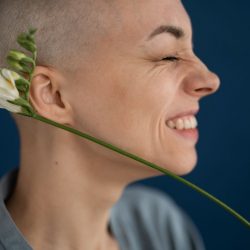Nowadays in France, breast cancer affects 1 in 8 people. Consequently, it is the leading cause of death in women. This risk increases with age.
Many factors are at the origin of cancers. All of them have in common an abnormal growth of cells, resulting in their uncontrolled proliferation.
The cancerization process is due to the accumulation of genetic events (genome alterations). This process leads to qualitative or quantitative changes in certain genes and, indeed, the proteins they encode.
A malignant tumor arises from a cell which has undergone an alteration in its genome and which, by successive divisions, gives rise to a cell clone which proliferates.
Breast Cancer :
This disease results from the cancerous transformation of a glandular cell in the breast, whether it is a cell in the milk ducts of the breast (ductal carcinoma of the breast) or a cell in the lobules of the breast, which is responsible for producing milk (lobular carcinoma of the breast).
The cancerization process results from the accumulation of successive errors in the genetic code, transmitted during each cell division. Cell division is a constant process in our body allowing the replacement of cells that die, due to aging or damage.
Cancerization results from an uncontrolled, uncontrolled and unlimited multiplication of the cancer cell. This will invade neighboring tissues, blood vessels and lymphatic vessels. This will correspond to the appearance of a tumor (local development), to the risk of developing lymph node metastasis (damage to the lymphatic vessels and then to the lymph nodes) and to the risk of distant metastasis in other organs (by passage through blood flow).
Invasion of nearby tissues reflects the infiltrating nature of the tumor, we will then speak of invasive mammary carcinoma (invasive ductal carcinoma or invasive lobular carcinoma).
In the breast, lesions that are not yet infiltrating can be detected which remain localized inside the milk ducts or milk lobules (ductal carcinoma in situ or lobular carcinoma in situ ). When these lesions are not in contact with the blood and lymphatic vessels, they do not expose the risk of lymph node metastasis or distant metastasis. On the other hand, it may be a relatively diffuse disease in the mammary gland that may require a larger surgery.
Pink October and breast cancer screening :
Pink October is an annual communication campaign aimed at raising awareness about breast cancer screening and raising funds for research, because early treatment can significantly improve the prognosis. The symbol of this event is a pink ribbon.
Progress and advances in the field of medical research against breast cancer are constant. Every day, researchers are mobilized in the fight.
In addition to advances in treatment, the fight against breast cancer also involves progress in breast cancer screening. These advances concern imaging and also genetic screening tests for breast cancer.
The main causes of breast cancer are on the one hand linked to age (by cell aging and the number of cell divisions it involves), and other contributing factors (early age of first rule, late menopause , having few or no children, late first pregnancy, etc.)
The genetic risk in breast cancer :
On the other hand, there is also a genetic risk involved in 5 to 10% of breast cancers, generally in families where several members are affected by hormone-dependent cancers:
- BRCA genes are genes predisposing to breast and ovarian cancer, but also of the testis, thymus, among others. They are transmitted according to the autosomal dominant mode, that is to say that the presence of a single mutated copy increases the risk of developing breast or ovarian cancer. The BRCA1 gene is located on the long arm of chromosome 17. It encodes a protein of 1863 amino acids, is present in 16% of breast cancers and 39% of ovarian cancers in women under 50 years old. It is a large gene, composed of 5592 nucleotides, which was identified in October 1994.
- The BRCA2 gene is located on the long arm of chromosome 13. It encodes a protein of 3418 amino acids. Large gene formed of 10,257 nucleotides, discovered in November 1995. We currently know more than 8,000 mutations of the BRCA1 gene and 200 of the BRCA2 gene. More recently, in February 2002, Australian researchers discovered the BRCA3 gene. 60% of women carrying one of the two mutations in this gene will develop breast cancer before the age of 70. With this discovery, a screening test could soon emerge.
What is a carcinoma ?
A carcinoma is a malignant tumor, made up of newly formed (or newly formed) epithelial cells, which has the ability to cause metastases in all organs of the body. Any organ containing epithelial cells is therefore likely to develop carcinoma and the severity of this cancer depends on its location.
When the carcinoma is multiple (by diffusion of metastases for example), one speaks of carcinoma or carcinomatosis. It is in fact the extension of a cancer to the whole organism.
Glandular carcinoma consists of cells more or less organized around a cavity and secretes a mucous substance. They mainly develop in the digestive tract: stomach, small intestine, colon and rectum, but also in the bronchi and lungs, and glands such as the breast, prostate, kidney or even the thyroid.
Cancer prevention :
Currently, 30 to 50% of cancers are preventable. Prevention involves reducing risk factors and applying existing preventive strategies:
- Avoid or reduce exposure to environmental and industrial factors
- Suppress tobacco
- Decrease the consumption of alcohol and saturated fat
- Limit sun exposure
- Enrich your diet with fiber, vitamins and antioxidants
- Promote information campaigns to raise public awareness of the dangers and risky behaviors
Cancer screening :
The chances of survival are however increased if the detection is early:
- Systematic screening according to age (colorectal, breast, uterus)
- Request for screening based on abnormal development of an organ or part of the body (melanoma)
- Information campaigns for all audiences
Cancer treatments :
- Chemotherapy: It will make it possible in particular to control the dissemination of cancerous cells through the blood with a prescription of drugs; our cites: monoclonal antibodies, antimitotics, photosensitizers, antiangiogens, enzymes, protein kinase inhibitors, cytotoxic chemotherapy. It requires several cycles of treatment in order to have a complete action on all cancer cells.
- Radiotherapy: This is a locoregional treatment that uses radiation to destroy cancer cells by blocking their ability to multiply. The irradiation will destroy all tumor cells while sparing healthy peripheral tissue.
- Hormone therapy: It consists of blocking the action or production of natural hormones in order to prevent the development of cancer cells. This type of treatment is undertaken over the long term.
“ MÊME “, a brand committed against breast cancer !
Designed for women affected by cancer, skin care products and beauty brand EVEN have been specifically formulated for use in oncology.
Chemotherapy, targeted therapies, radiotherapy… cancer treatments, however, can have side effects on your body. Dry skin, damaged nails, a more fragile and sensitive scalp, feelings of discomfort on your hands and feet; it is therefore necessary to take care of yourself from the start of treatments with suitable dermatological care!
MÊME products are the requirement and expertise of dermo-cosmetics combined with the pleasure and softness of beauty products designed just for you. Developed with women undergoing treatment, they essentially meet the specific needs of skin weakened by cancer treatments.
It all started with the experience of the death from cancer of the mother of one of the brand’s founders. For her, not looking sick, preserving her image and her self-esteem is a strategy to fight against the disease as long as possible.
Reclaiming your femininity so altered by the treatments can really help to be psychologically stronger in order to better fight against cancer.
Their commitments :
MÊME is the first brand of beauty products entirely dedicated to women affected by cancer, which is not only expert but also and above all DE-SI-RABLE and feminine, in the trends of the moment.
The opening in October is an important moment every year at MÊME . Indeed, in an adventure like this, this month is often directly linked to Pink October, these 31 days dedicated to awareness and prevention against breast cancer.
Thus, from the very beginning, MÊME has worked all year round with more than 200 associations, health professionals and supportive care workers who work for the well-being of people affected by cancer.
Throughout the year, 1% of their turnover is donated to Unicancer, the only French hospital network entirely dedicated to the fight against cancer, in order to advance the improvement of care, research and teaching in oncology.
In summary :
The realities of breast cancer:
- Over 50,000 new cases each year
- 1 in 8 women will be affected by the disease in her lifetime
- 12,000 deaths per year in France
- Most common cancer in women
- From 25 years old, palpation by a healthcare professional once a year is recommended
- From the age of 50, a mammogram should be performed every two years
- The right to testing saves lives
- Detected at an early stage, breast cancer can be cured in 9 out of 10 cases





